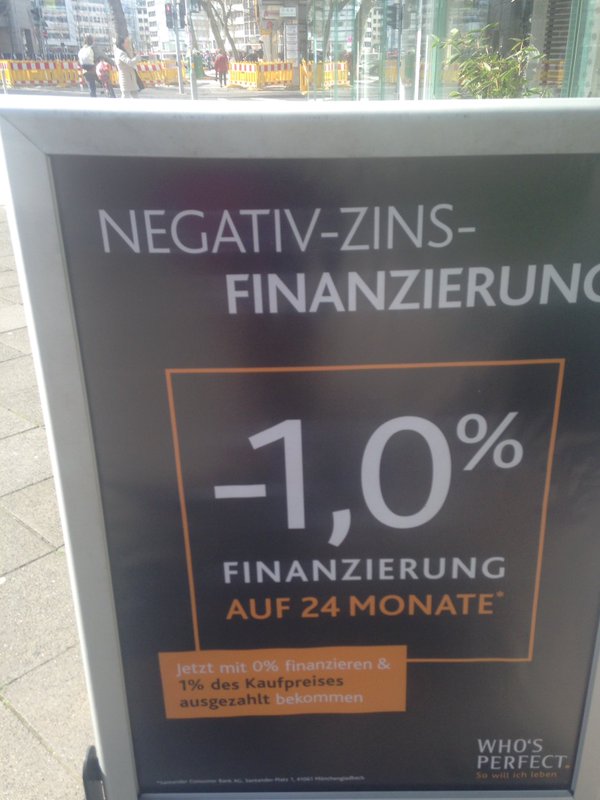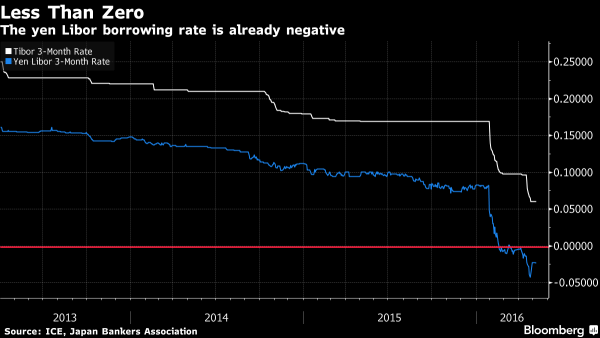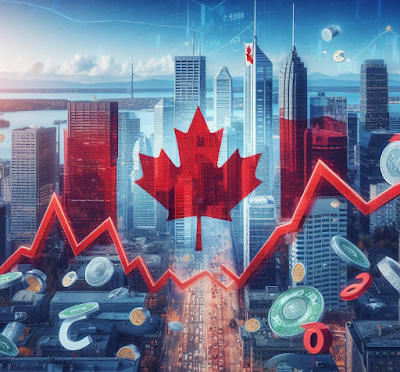Negative Consumer Financing Rates in GermanyThings are increasingly upside down in the brave new centrally planned world: thanks to negative deposit rates central banks have put an explicit cost on saving, while in various instances, such as taking out a mortgage in Denmark and the Netherlands, the bank actually pays the borrower, thus rewarding living beyond one’s means. Curiously, it was just a month ago when an offer was spotted in Germany offering a negative -1% rate on small consumer loans issued by Santander Bank. However, so far these cases have been isolated to institutional entities largely sparing the broader population. However, that may change soon. |
 |
Japan to Pay Borrowers for accepting loansAccording to Bloomberg, Japanese banks may soon pay borrowers to accept loans if they can raise funds at even cheaper rates. Negative interest-rate lending is increasingly becoming a reality since the Bank of Japan started levying charges on idle cash. Lenders can now borrow for three months in the Tokyo interbank market at a record-low 6 basis-point annualized rate, versus 17 basis points since the BOJ move in January. They may eventually be able to be paid to borrow and then profit by paying less to lend, according to Credit Suisse Group AG, JPMorgan Chase & Co. and SMBC Nikko Securities Inc. This is also known as shoving money down people’s throats… and then paying them for it. However, a catalyst would be required to unleash negative rate loans: a negative Tibor. “Banks paying interest to borrowers is possible if the Tibor goes negative,” said Shinichiro Nakamura, a senior analyst in Tokyo at SMBC Nikko Securities, a unit of Japan’s second-biggest lender by market value. “Many large-cap companies in Japan are borrowing funds from banks around the same level as the Tibor.” If the Tibor falls to minus 0.2%, “it would make sense to lend at minus 0.1 percent to companies with little credit risk,” said SMBC Nikko’s Nakamura. He expects the BOJ to cut the interest on some reserves by another 10 basis points to minus 0.2 percent by March 2017. If Tibor falls further, then banks may just lend direct to consumers as well. |
 Things are increasingly upside down in the brave new centrally planned world: thanks to negative deposit rates central banks have put an explicit cost on saving, while in various instances, such as taking out a mortgage in Denmark and the Netherlands, the bank actually pays the borrower, thus rewarding living beyond one's means. - Click to enlarge |
But while consumers may greet the arrival of self-amortizing loans – even if it ultimately means even more unrepayable debt – this is bad news for the banks, which already slowed their loan growth to 2 percent in March amid shrinking profit margins and slumping confidence among customers. Negative-rate loans would hurt margins at banks, which find it hard to charge customers for deposits, so they will focus on areas such as fee businesses and foreign investments, according to Pacific Investment Management Co.
“Because it is difficult for banks to charge negative rates to customers for deposits, this will likely lead to net interest margin compression and deterioration in profitability,” Raja Mukherji, the Hong Kong-based head of Asian credit research at Pimco, wrote in a report.
How long until negative loans are a reality? Well the Yen London rate has already dropped below zero. Companies including Takeda Pharmaceutical Co. and Mitsubishi Corp. have taken out loans at one basis point over the three-month yen Libor, according to data compiled by Bloomberg. If they refinance with the same terms, they would in effect borrow at a negative rate based on current Libor levels. Other such as Sumitomo Mitsui Finance & Leasing are already getting paid to borrow after they got a rate of minus 0.001% when the company raised 5 billion yen in March via the sale of six-month six-month commercial paper.
If negative rate loans come to Japan will Europe follow? Probably not without some additional changes to the ECB’s policy first. That’s because base lending rates are higher in Europe than in Japan. Germany’s average effective lending rate to non-financial companies was 2.2% in March while a similar gauge for France was 1.89%. The average rate on new loans in Japan was 0.793 percent in February, BOJ data show.
UBS May Apply Negative Interest Rates for More Clients
But while European banks may not be rushing to pay for the privilege of taking out a loan, they are getting closer to charging depositors for the privilege of holding money at the bank. Reuters writes that UBS could pass on negative interest rates to wealthy private customers or add new service fees to ensure profitability and capital returns in the current environment, its chief executive said on Tuesday.
UBS already passes on negative interest rates to corporate clients, but CEO Sergio Ermotti’s admission is a sign of the pressure Swiss banks are under due to the Swiss National Bank’s negative interest rate policy.
“If the conditions remain as they are or grow worse, we will have to consider extending these measures to very wealthy clients and increasing interest rates on loans,” Ermotti said at the group’s annual general meeting on Tuesday.
“Or we will have to demand payment for services that were previously free – with the possibility that additional fee adjustments in the future will also be necessary.”
Low or negative interest rates meant banks had to weigh taking on client assets against the costs these incurred for the institution and the “unreasonably large amount” of capital with which they needed to back up liquid assets.
At first it will be the very wealthy, then it will be everybody else. And as ordinary people who barely have an interest, let along understanding of “modern” monetary polixy learn that everything they have been taught about savings and borrowing money is inverted upside down, and as concern about just how bad things around the world must be for even their neighborhood bank to have to take such drastic measures, the central banks will wonder how it is that the narrative of the “global” recovery has failed to take hold some 7 years later. After all, just look at global stock markets: once again approaching all time highs, and somehow nobody believes the lies any more.
Full story here Are you the author? Previous post See more for Next postTags: Bank of Japan,central banks,Commercial Paper,Credit Suisse,France,Japan,Japanese yen,JPMorgan Chase,Libor,Netherlands,newslettersent,Reality,recovery,Reuters,Swiss Banks





































